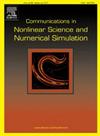用扩展伽辽金方法研究了具有分数阶导数恢复力的Duffing振子的主共振
IF 3.4
2区 数学
Q1 MATHEMATICS, APPLIED
Communications in Nonlinear Science and Numerical Simulation
Pub Date : 2025-01-15
DOI:10.1016/j.cnsns.2025.108619
引用次数: 0
摘要
非线性振动广泛存在于许多科学和工程问题中,需要通过各种技术来解决,以满足求解的要求。对于许多不同的非线性特征方程,已经提出并测试了近似方法,以便在处理日益复杂的问题时实现简单,准确和有效的解决程序。在非线性振动方程中引入分数阶导数作为恢复力,在处理一些耗散和激励因素方面具有优势,但其复杂性也明显增加,求解技术的适用性和有效性有待于应变试验。为了以更简单的方法应对新求解技术的挑战,将非线性振动分析的扩展伽辽金方法应用于分数阶导数问题,通过将积分区间展开为大量周期,得到了振幅的近似解并进行了验证。研究表明,扩展伽辽金方法是求解分数阶导数项非线性振动方程的有效方法,扩展了新方法的应用范围,并以较简单的过程提供了求解方法。本文章由计算机程序翻译,如有差异,请以英文原文为准。
The primary resonance of a Duffing oscillator with a restoring force of fractional-order derivatives by the extended Galerkin method
The nonlinear vibrations have wide appearances in many scientific and engineering problems to be solved by various techniques to satisfy requirements for solutions. With many different equations of nonlinear features, approximate methods have been suggested and tested to enable simple, accurate, and efficient solution procedures in dealing with increasingly complex problems. The introduction of fractional-order derivative as a restoring force in nonlinear vibration equations brought in advantages in dealing with some dissipation and excitation factors, but the complexity has also increased significantly, and the solution techniques are in strained testing for applicability and efficiency. To meet the challenges for newer solution techniques with a simpler procedure, the extended Galerkin method for nonlinear vibration analysis is applied to such problems with fractional-order derivatives through the expansion of integration interval to large number of periods, and approximate solutions of amplitudes are obtained and validated. This study demonstrates that the extended Galerkin method is an effective procedure for the nonlinear vibration equations with fractional-order derivative terms, expanding the application of the newer method and providing solutions with a simpler procedure.
求助全文
通过发布文献求助,成功后即可免费获取论文全文。
去求助
来源期刊

Communications in Nonlinear Science and Numerical Simulation
MATHEMATICS, APPLIED-MATHEMATICS, INTERDISCIPLINARY APPLICATIONS
CiteScore
6.80
自引率
7.70%
发文量
378
审稿时长
78 days
期刊介绍:
The journal publishes original research findings on experimental observation, mathematical modeling, theoretical analysis and numerical simulation, for more accurate description, better prediction or novel application, of nonlinear phenomena in science and engineering. It offers a venue for researchers to make rapid exchange of ideas and techniques in nonlinear science and complexity.
The submission of manuscripts with cross-disciplinary approaches in nonlinear science and complexity is particularly encouraged.
Topics of interest:
Nonlinear differential or delay equations, Lie group analysis and asymptotic methods, Discontinuous systems, Fractals, Fractional calculus and dynamics, Nonlinear effects in quantum mechanics, Nonlinear stochastic processes, Experimental nonlinear science, Time-series and signal analysis, Computational methods and simulations in nonlinear science and engineering, Control of dynamical systems, Synchronization, Lyapunov analysis, High-dimensional chaos and turbulence, Chaos in Hamiltonian systems, Integrable systems and solitons, Collective behavior in many-body systems, Biological physics and networks, Nonlinear mechanical systems, Complex systems and complexity.
No length limitation for contributions is set, but only concisely written manuscripts are published. Brief papers are published on the basis of Rapid Communications. Discussions of previously published papers are welcome.
 求助内容:
求助内容: 应助结果提醒方式:
应助结果提醒方式:


